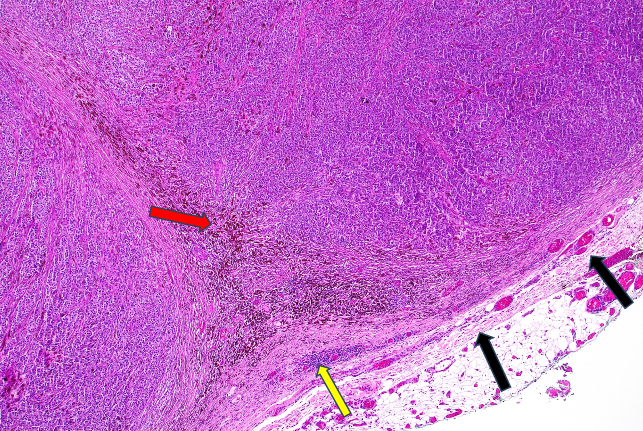If you or someone you know has unfortunately been diagnosed with cancer, you may have heard the term «metastasis» or saw it in a Pathology report. But what exactly is a metastasis and what significance does it have on cancer stage and prognosis?
Simply put, metastasis is when tumor cells break free from where they originated and travel to other parts of the body, usually through blood or lymphatic vessels. The ability to metastasize is one of the hallmarks of cancer along with immortality of tumor cells and sustained proliferation, among others. Examples of metastasis would be finding breast cancer cells in the lungs or colon cancer cells in the liver. Normal tissues and benign tumors don’t metastasize.
A common site of malignant tumor metastasis is regional lymph nodes. Lymph nodes are encapsulated collections of immune cells found throughout the body which play an important role in our immune defenses. In the case of colon cancer, tumor cells may travel to any number of the lymph nodes surrounding the outer layers of the colon, become sequestered there and continue proliferating. When a segment of the colon is removed, all lymph nodes are identified by the pathologist and subsequently examined for tumor cells microscopically. If tumor cells are present, that constitutes lymph node metastasis and signifies a more aggressive tumor, higher tumor stage and possibly worse prognosis.

In the case depicted in the photos we received 2 lymph nodes which were removed from a 63-year-old man on suspicion of «cysts» in the right armpit (axilla). There is no cyst, but instead, we see a lymph node which is completely filled and expanded by pink tumor cells (top photo) with a high proliferation rate as evidenced by the many mitoses (circled). The lymph node structure is only identifiable by the capsule (black arrows) and the few remaining normal lymphocytes which are pushed and compressed to the side (yellow arrow). The pigment production (red arrow) of the tumor was highly suspicious for Melanoma.
There was no clinical history of a known primary tumor, so Immunohistochemistry was performed with specific tumor markers to determine the tumor type. The tumor was negative for various carcinoma and lymphoma markers but was positive for melanoma markers including SOX-10 and Melan A.


It was clear that the origin of the metastasis was from a malignant melanoma, but the patient’s doctor didn’t notice any skin lesions… so why was that? Well, Malignant Melanoma can spontaneously regress and disappear from the skin, but in the meantime, there may be circulating tumor cells and metastases in other places in the body. We suspect that the patient had a melanoma on his right shoulder, upper back or neck area which regressed and visibly disappeared from the skin, escaping detection on physical exam. The patient’s doctor was advised to examine the patient thoroughly for a pigmented tumor, including asking him if he had noticed a brown spot that disappeared.
If you have any questions about your Pathology report, please contact us for clarification.
Dr. Culton MD
